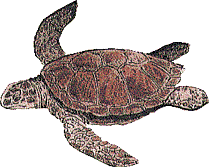
At this station, your team will measure the amount of dissolved oxygen in
the water and learn what that measurement indicates about your aquatic site.
Animals living in the water depend on the dissolved oxygen to live. Its
concentration is a critical indicator of the water's ability to support a variety of life forms.
Materials
For the Pre-Field station:
- Small pill bottle with cap
- Bucket or large container filled with a mixture of water and grass (to
simulate pond water)
- Your team's copy of Master 4a, "Baseline Study and Possible Human Impact
Assessment Form"
For the field station:
- Oxygen tablets
- One very small, clear pill bottle with a cap
- Empty bucket or other large container
- Your team's copy of Master 4a, "Baseline Study and Possible Human Impact
Assessment Form"
Methods
Pre-Field Experiment:
- Submerge your small pill bottle in the bucket of water and grass mixture.
Once the bottle is full of water, cap it while it is still underwater.
- Remove the bottle from the bucket. Look into the bottle and make sure
there are no air bubbles. If there are, pour out the sample and start again.
- In the field, you will watch your teacher add oxygen tablets to the bottle,
recap the bottle, and shake it until the tablets have dissolved. Then you will
notice that the water has changed color. The tablets contain a chemical that
reacts with the oxygen dissolved in the water to turn the water a different
color-indicating how much dissolved oxygen is in the water. Because you
do not have oxygen tablets for the Pre-Field Experiment, simply cap the
bottle and shake it. Each team member should practice getting a sample
with no oxygen bubbles in it.
- Pretend that your water turns light pink, indicating a low level of dissolved
oxygen. Look at Master 4a, "Baseline Study and Possible Human Impact
Assessment Form." How many points would you receive for low oxygen
content? What do you think the different dissolved oxygen levels indicate
about an aquatic environment?
Field Experiment
Note: This Experiment will be done as a class demonstration. Members of
your team may be asked to assist.
- Take a sample of water from the aquatic site.
- Submerge a small pill bottle in the bucket of water and cap it. Remove the
bottle from the bucket. Look into the bottle and make sure there are no air
bubbles. If there are, pour out the sample and start again.
- Once you are sure that your sample has no air bubbles, take off the cap and
add one oxygen tablet for every 2 teaspoons of water in the bottle. (Note: It
is very important that you keep the ratio of 1 tablet to 2 teaspoons of water.)
Recap the bottle and shake it until the tablets have dissolved. (Note: It may
take up to 5 minutes for the tablets to dissolve.) Once the tablets have
dissolved, observe what color the water has turned. Light pink water
indicates low levels of dissolved oxygen. Bright orange water indicates high
levels of dissolved oxygen. If the water remains clear there is no dissolved
oxygen in the water. The change in color may be faint. It might help to hold
a piece of white paper (use one of the Masters) behind the bottle when
examining the color. If you are unsure of the results, the teacher may
perform the Experiment again if there are enough oxygen tablets.
- Record the dissolved oxygen level on Master 4a, "Baseline Study and
Possible Human Impact Assessment Form." How many points did you
score? What do you think this indicates about your aquatic environment?
Conclusions
After you have conducted both the Pre-Field and Field Experiments, discuss
the following questions within your research team and record your answers
in your JASON Journal.
- How can we determine the amount of dissolved oxygen in water, and how
does it relate to the kinds of invertebrates you found at your site?
- What characteristics do you think affect the amount of dissolved oxygen in
the water.
- What new questions do you have?
- Look for more answers to your questions in the JASON Online Systems,
the library, and science textbooks.

Return to the Aquatic Field Investigation
JASON VII Home Page


JASON Project Homepage ||
Teachers' Guide ||
Students' Corner ||
Search
Gene Carl Feldman
(gene@seawifs.gsfc.nasa.gov)
(301) 286-9428
Todd Carlo Viola, JASON Foundation for Education (todd@jason.org)
Revised: 3 Nov 1995
![]()
![]()